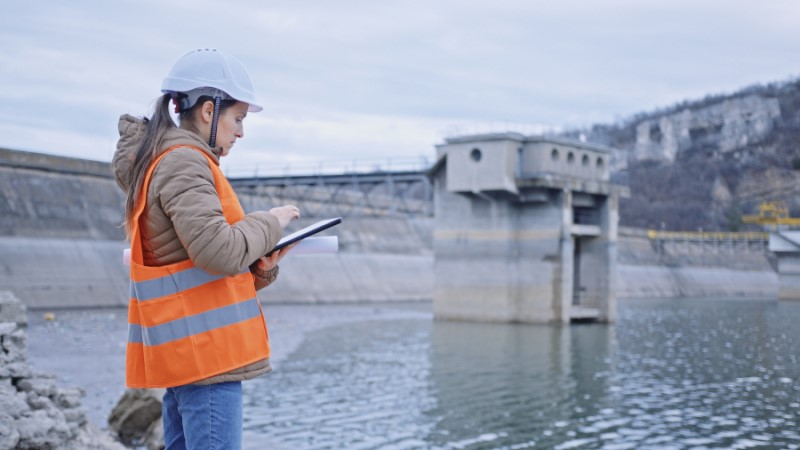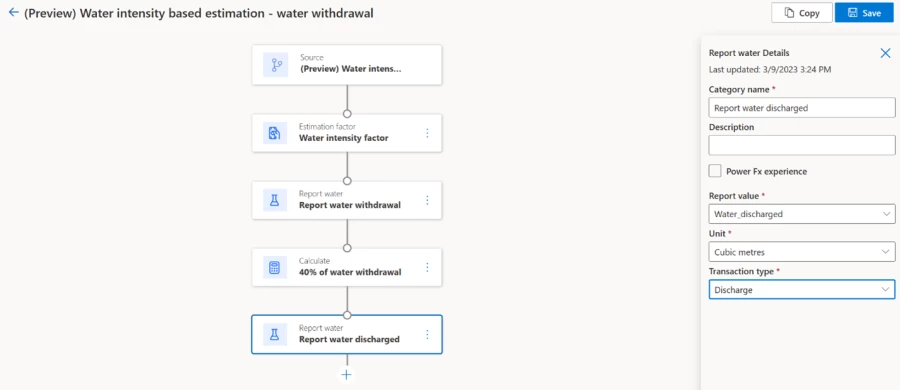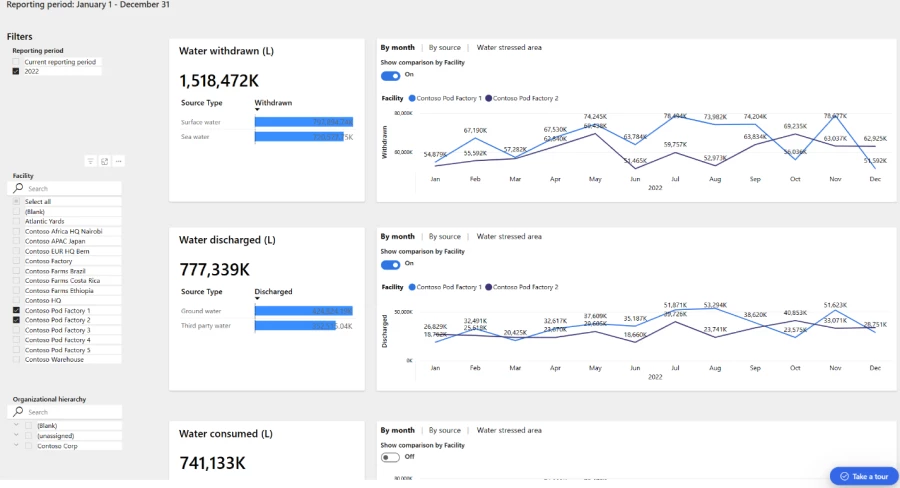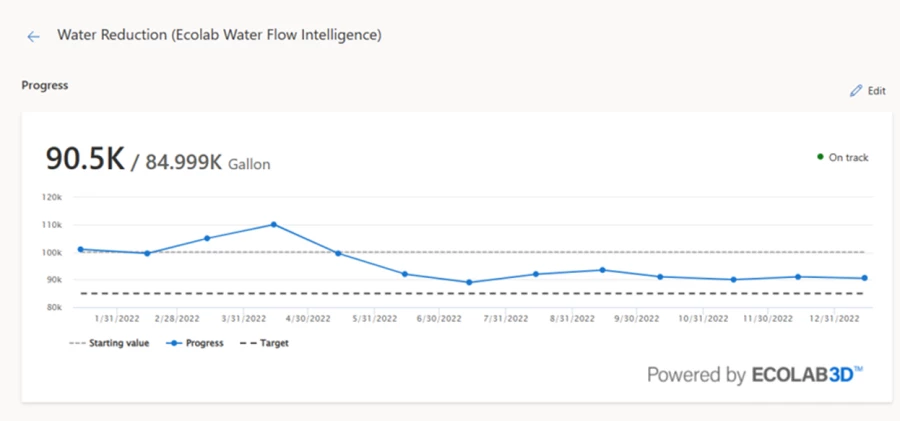
Introducing critical new water data capabilities in Microsoft Cloud for Sustainability
With the United Nations’ 2023 Water Conference kicking off this week, the world’s attention is turned to the extreme importance of water sustainability for meeting the United Nation’s Sustainable Development Goals. People, agriculture, ecosystems, and commerce all depend on water, but increased demand and less reliable water supply have put the world at a critical turning point: Sustainable water management must be prioritized.
For organizations, this means meeting regulations about water usage, accessibility, and quality, such as the United States Clean Water Act, the British Columbia Water Sustainability Act, and the European Union’s Drinking Water Directive. And it means meeting mandatory environmental, social, and governance (ESG) disclosure rules about water impact as required by government authorities and securities boards.
Along with emerging regulations, growing pressure from customers and stakeholders is compelling organizations around the world to improve water sustainability practices. This means using water efficiently, recycling wastewater, replenishing water sources near physical sites, and ensuring that wastewater is returned to local water ecosystems in ways that are non-polluting and compliant with water discharge regulations. The pinnacle achievement of water sustainability is becoming water positive—that is, replenishing more freshwater in the ecosystem than is consumed.
Today, Microsoft shared an update on progress against our water positive commitment and announced powerful new water sustainability management features (in preview) in Microsoft Cloud for Sustainability to help Microsoft and our customers and partners meet their water commitments. We’re also excited to share that we have an extended collaboration with Ecolab that aims to help organizations accelerate their sustainability progress with enhanced visibility of water consumption data.

Accelerate your sustainability journey
Drive operational and cost efficiencies to help meet your sustainability goals with Microsoft Cloud for Sustainability.
Taking a flexible, data-first approach to water sustainability
As the saying goes, you can’t manage what you can’t measure, and measuring requires data. Currently, organizations are challenged by disparate water data sources that are spread across multiple sites and variously connected to sensor equipment for data tracking, or not. All of this impedes water sustainability measurement and progress.
The new capabilities in Microsoft Cloud for Sustainability focus on standardizing water data for water sustainability use cases, providing a single source of truth through multi-source data acquisition and using the purpose-built Microsoft Cloud for Sustainability water data model (preview) to enable efficient calculations, visualization, analysis, and reporting.
Using Microsoft Sustainability Manager, a Microsoft Cloud for Sustainability solution, organizations can more easily overcome water accounting challenges with:
- A unified view of water sustainability data through visualizations and organizational reports.
- Tracking against mandatory and voluntary reporting requirements using custom data model configurations, monitoring, and reporting.
Automatically or manually ingest water quantity and quality data from diverse sources
No matter what their facilities’ geographic layout or degree of connected measuring, organizations can use Microsoft Sustainability Manager to leverage water data to help meet goals. Using the solution, they can automatically ingest aggregated water quantity and quality measurement data and water sustainability reference data from varied sources, in common file formats like Microsoft Excel, CSV, and XML and stored in Microsoft Azure data services such as Azure Data Lake Storage and Azure SQL Database.
Organizations can pull in historical data and, notably, still manually ingest water data from undigitized data sources, such as paper-based utility invoices or lab test reports, by using data ingestion forms. After ingestion, the data is stored in the water data model and linked to relevant water sustainability reference data in preparation for water sustainability use cases.
The data model includes entities for storing water volumes related to water consumption, withdrawal, and discharge—water quality and effluent data measured from wastewater samples—and water sustainability metadata.
Estimate water usage volumes with factor-based computation
Organizations may not always have measured values for water withdrawal or discharge volumes. Some operate a mix of facilities, some with sensor-connected withdrawals and discharges and some without, and some organizations are newer to instrumenting their facilities to measure water quantities. In these cases, the water intensity feature in Microsoft Sustainability Manager can be used to estimate water volumes—for example, to estimate gallons of water used per square foot—to gain an understanding of overall water inflow and outflow that’s needed to make progress on goals.

In the screenshot above, an organization overcomes a gap in digital water measurement data by estimating water withdrawn and discharged at a non-instrumented facility. The solution shows a return of only 40 percent of withdrawn water to local water sources, making it a water-intensive facility.
Visualize, filter, and share detailed water-usage data
Water reporting is often required down to the individual facility and other granular attributes. With Microsoft Sustainability Manager interactive dashboards, built on Microsoft Power BI market-leading analytics, organizations can view up-to-date and historical water quantity and quality data—formatted and prepared for sustainability use cases such as water, mass, balance, and quality compliance—by facility and aggregated across facilities. They can also filter, roll up, and drill down through the data by time, water type, and asset.

Above, the water quantity dashboard provides insights into the total water withdrawn, consumed, and discharged by Contoso Corp, a fictitious company, across its facilities over a period of one year. This includes water received from surface and seawater sources as well as treated wastewater that’s discharged to groundwater and a utility company’s storm drains. The dashboard also shows the water that’s consumed by Contoso Corp as water withdrawn into facilities but not discharged back into local water ecosystems.
With ESG disclosure requirements and expectations mounting, organizations need tools to facilitate timely and accurate responses. With Microsoft Sustainability Manager, they can now configure water usage and wastewater quality reports according to the metrics they know are required by applicable ESG disclosure standards. For example, an organization that needs to report on wastewater effluent by the facility can both visualize metrics at that level and generate reports aligned to prescribed discharge monitoring standards.
Microsoft Cloud for Sustainability partner co-innovation: Taking water accounting to the next level
Perhaps most importantly, the new water data capabilities in Microsoft Sustainability Manager provide a foothold for leading-edge innovation by specialized Microsoft partners. Our partners around the world have the industry knowledge to zoom in on organizations’ unique water and sustainability goals and develop advanced solutions to meet them.
Today we’re announcing our recent work with Ecolab, a global sustainability leader in water, hygiene, and infection prevention. Our joint solution combines the power of the ECOLAB3D™ digital platform with Microsoft Sustainability Manager, helping organizations monitor and manage water data so they can gain greater visibility into how they’re tracking against water and sustainability goals.

Ecolab is committed to achieving a net positive water impact in its operations, with goals to restore more than 50 percent of its water withdrawal at high-risk sites by 2030 and reduce its water impact by 40 percent per unit of production across its enterprise. The company is also committed to helping its customers reduce their water use, energy use, and greenhouse gas emissions. They recently launched the Ecolab Water for Climate™ program, which offers holistic solutions including auditing, consulting, engineering, connected chemistries, and digital solutions to help support reduce, reuse, and recycle water strategies across an enterprise.
Together, Microsoft and Ecolab plan to help:
- Unify water and sustainability data. Centralize water consumption data and integrate it with other environmental, financial, and operational data. This will lead to improving reporting and helping organizations manage progress against goals with Microsoft Cloud for Sustainability and ECOLAB3D.
- Reduce water consumption and costs. Maximize efficiencies and reduce water usage at the site level and enterprise-wide with actionable intelligence and outcome-based water solutions tailored to industry scenarios.
- Lower energy consumption and greenhouse gas emissions. Use digital technologies to help link water efficiencies with energy savings and reduced greenhouse gas emissions. This water-energy nexus is the relationship between the water used to generate and transmit energy and the energy required to move, cool, heat, and treat water.
- Drive transformation that benefits the planet and business. Cultivate sustainability and business intelligence to inform more effective, value-based decisions that help organizations reduce their environmental footprint, manage risk, and grow and scale their operations.
Next steps
- Learn more about ECOLAB3D and discover other partner solutions on Microsoft AppSource.
- Get started with water sustainability management: Set up and configure Microsoft Cloud for Sustainability.
Want to learn more about Microsoft’s water sustainability? Read our annual sustainably report and stay informed about Microsoft Cloud for Sustainability by signing up for news and updates.




